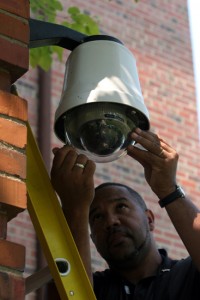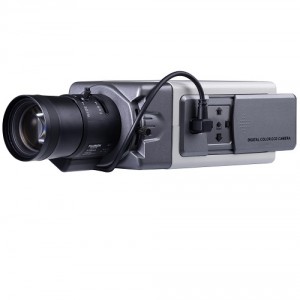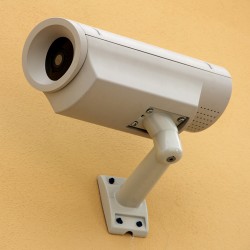 Security cameras are designed to monitor areas of your home or yard that an intruder might try to enter in through. You can opt to install the security camera system yourself, as long as you have already bought the wireless transmission kit and some other basic supplies from your local supply store. A few tools will be required as well, but most people already have them in their home already. There is no need to tear up the lawn because the camera is going to obtain power through a power outlet on one of the outside walls of your home.
Security cameras are designed to monitor areas of your home or yard that an intruder might try to enter in through. You can opt to install the security camera system yourself, as long as you have already bought the wireless transmission kit and some other basic supplies from your local supply store. A few tools will be required as well, but most people already have them in their home already. There is no need to tear up the lawn because the camera is going to obtain power through a power outlet on one of the outside walls of your home.
Step-by-Step Instructions for Installation
1. Begin by placing the rail that came with the outdoor housing on a table horizontally. Make sure the tripod screw is facing upwards. Screw the screen into the base of the video camera to join the two items together. You want to make sure they are flush.
2. Take both ends of your wire and remove a half inch of insulation from both ends using wire strippers. Place one end of the wires into either one of the two holes found on the back of the camera. You will first need to depress the tab. Release the tab so that it grabs onto the wire. Repeat the same procedure with the other wire and the opposite hole, which can be found directly next to where you already put the other wire.
3. Place your outdoor housing on the table face up. Remove any screws from the side of the unit with a Phillips screwdriver. Remove the cover from the outdoor housing and set it to the side.
4. Place your camera inside of the outdoor housing with the rail side facing down, which allows the lens to face toward the transparent covering at the end. Make sure the rail is aligned with the groove. Move your railing forward so that the front of your lens is resting against the transparent cover. Screw into the holes on the sides of the railing to help secure it onto the bottom of the outdoor housing, which will require a Phillips screwdriver.
5. Press into one tab on the power block at the opposite end of the housing farthest from you. Insert your exposed wire ends from the attached camera that is farthest from where you are inside of the hole. Release your tab. Press in the other tab on the power block and place the other exposed wire into the hole on the camera. Release that tab as well.
6. Cut the female socket off at the end of your weather-resistant extension cord. Make a slit between the two wires using a utility knife. Pull the wires apart using your hands. Take a half inch of insulation off the ends of the two wires using your wire strippers.
7. Push your wires into the back hole located on the outdoor housing. It may be necessary to punch the metal disc out beforehand using your fingers. Press in the tab on the side of the block farthest away from you. Take the two exposed ends of one wire, place one of them into the hole, and let the tab go. Press the other tab in and insert the other wire into the opening. Release that tab. Make sure to tape the inside of the hole with some duct tape to cover up the hole.
8. Place your cover back over the housing and reattach all of the screws. Decide which area of your yard you will be monitoring with your wireless security camera. Stand a tripod in the area. Screw the top tripod screw into the hole on the tripod at the base of the housing. If there is not a hole for the tripod on the outdoor housing, you will need to twist the screw off the tripod using pliers. Apply a small amount of bonding glue onto the top of the tripod and place the bottom of the housing onto the glue.
9. Plug your AC socket from the end of the weather-resistant cord into one of the wall outlets on your outside wall to help provide the camera with the power it needs.
Picking an Outdoor Security Camera

It doesn’t matter where you live because there is always the potential of someone trying to break into your home and rob you blind. In order to help give you the peace of mind you need in regards to your safety, as well as that of your loved ones and belongings, you might want to look into installing one of the outdoor security cameras. Surveillance systems help to deter any criminals and let them know who is on the property around the clock. If you have made the decision that a security camera is the right choice for your home, you need to understand your options before making the final purchase decision.
Instructions for Picking a Camera
1. Go through and do your research concerning the differences between a wired camera and a wireless one. Wired cameras are often not as convenient as their wireless counterparts are because they have restrictions upon where you can place them. However, they do offer an amazing output when it comes to the quality of the video. The wireless units are a little more costly than and not as reliable as the wired ones. You do have the added convenience of being able to place them wherever it is that you need them to help them remain hidden.
2. Look through all of the specific features involved in the cameras you are considering purchasing. The size of the chip in the camera is going to affect its end performance. Larger chips of ½ inch are going to provide you with the best type of video quality. While the smaller chips of ¼ have the capability of producing the same quality as the larger chips but only if they are higher density. The higher the amount of television lines are for resolution, the better your picture quality is going to be. Large television lines will range from 480 up to 570. You will also need to pay attention to your viewing fields for the camera lens. On average, a 72-degree field of viewing will work quite well for the majority of your security cameras, but the larger viewing fields are also available with a wider lens.
3. Avoid buying any security cameras that record audio as well as video. If you record a person’s voice without them knowing about it and giving consent, you could end up in trouble because it is illegal. However, it is perfectly acceptable to record their images. Cameras recording audio are not intended for use as an outdoor camera.
4. Pay close attention to the difference between black and white and their color counterparts when looking at an outdoor camera. Black and white cameras are capable of producing a far better quality of image during the nighttime than that of color cameras, and they are normally not as expensive either. However, the color cameras are capable of producing an increased degree of imaging during the daytime.
Hiding Your Outdoor Cameras
Security cameras are an integral part of everyday life. Most people are used to seeing these cameras on the streets, in a parking lot or at the entrance into a housing development. Due to the competitive nature of these systems, many homeowners jump on the opportunity to protect their property and their loved ones with one of the security systems installed on the entrance to their home, in the backyard or other important points of entry. The wireless systems are the easiest of all when it comes to hiding them, which should not give you as many complaints when it comes to neighbors and monitoring any activity in the neighborhood. You can disguise your camera as a birdhouse, floodlight or even a cupola.
Disguising the Camera
1. Choose the perfect location for placing your camera. Select a site providing your camera with a clear line of sight to your rear and front doors, sidewalks or other areas that are dark around the yard. This area should be free of debris and obstructions that might prohibit the field of view. You will want to make sure you have the largest amount of surveillance possible.
2. Attach the element of disguise onto a structure or tree branch. Use screws, nails, or wire to secure the element to the surrounding structure. If at all necessary, you might want to use a piece of plywood or other piece of metal to help maintain the casing. Make sure it is secured tightly and that way no rain or winds will be able to dislodge the housing and the camera.
3. Place the camera in disguise and then secure it to the area with screws or some other form of mechanical means such as clamps or rope.
4. Check the item out to make sure that it can shelter the camera from all the elements and keep it disguised properly.
5. Test out the camera. Go through the angles and its surveillance range to make sure it is covering the area that you need monitored.
6. Adjust the camera’s position and its casing as necessary.
Buying an Outdoor Security Camera
Even though security systems can be found in just about any electronics store, there are numerous options to choose from which can make the buying process difficult to choose which camera is going to work the best for your needs. When buying an outdoor camera, there are things you need to bear in mind to make the best choice.
1. Determine the features you need in a security system and those that you can ignore. Most of the time, people choose to install a security camera on the outside of one’s home, but some experts suggest that a garage door, back door or shed door might be just as beneficial to your safety. Some homeowners are placing the cameras inside their garbage cans for fear of identity theft.
2. Determine the method in which you will mount your camera. Most of the cameras will need to be mounted directly onto a ledge or wall. If that is not possible, you might want to choose a camera with other options for mounting the unit, such as adhesives or straps.
3. Consider the climate of the area throughout the year. Areas that receive a lot of snow or rain will need to have a sturdier housing than others that have a more consistent climate.
4. Account for your electrical skills. A wireless camera is a lot simpler to install for a beginner, but the wired systems are far more reliable.
5. Determine if you are planning to record any video. This additional feature will require more hardware and often will cost more money out of pocket. If you are only planning to use your camera for identifying a stranger at your door, you will not need to worry about being able to record anything.
6. Make a list of all the features you need, want and those that you do not need. Take that list with you when you head to the store. If you are shopping online, make sure that list is close to the computer.
7. Ask an associate for assistance in finding the camera for all of your needs. Some of the associates, especially those in a store specializing in security equipment or home security systems, are well trained when it comes to determining your needs and recommending the perfect solution for your next surveillance system.
Purchasing a security system for the outside of your home will help ensure everyone is taken care of and your property is protected. The last thing you should have to worry about is feeling scared in your own home, which is why one of these units is ideal for all of your property and personal safety needs. Check into yours today and see for yourself just how much of a difference it can make for you.
If you have any questions or looking for further information, please do not hesitate to contact us. It is our pleasure to help you.
